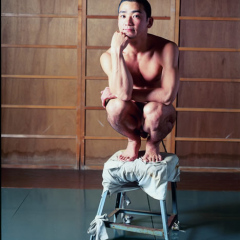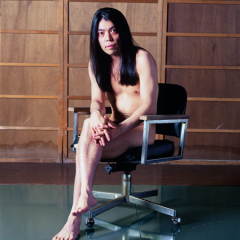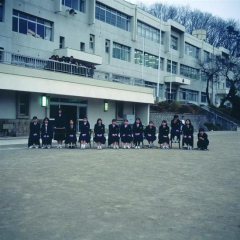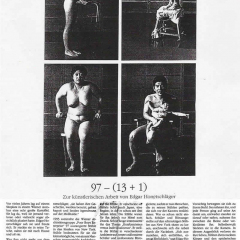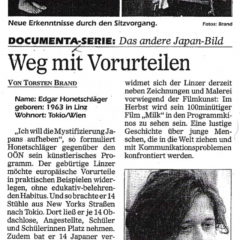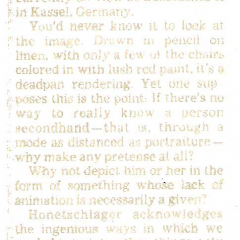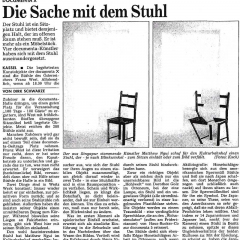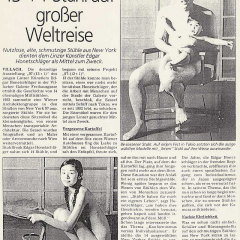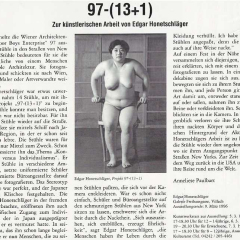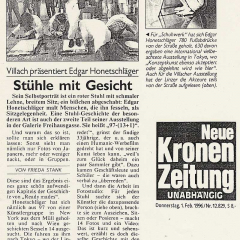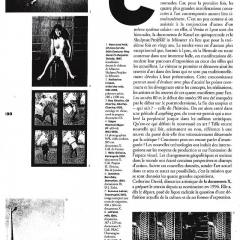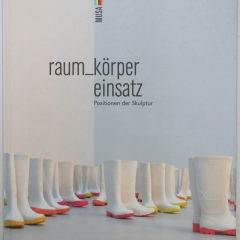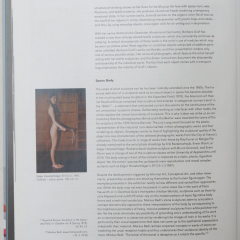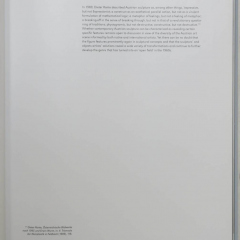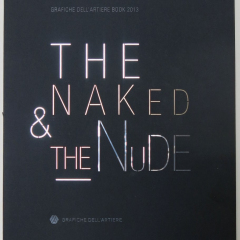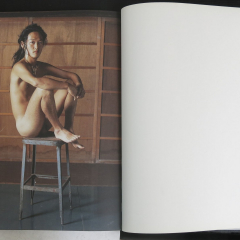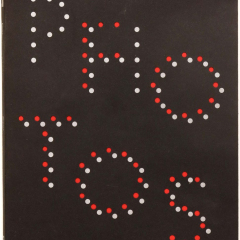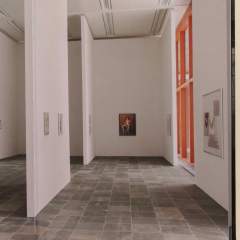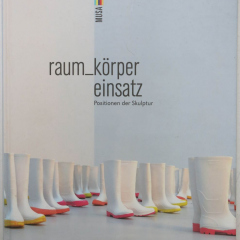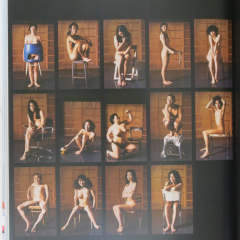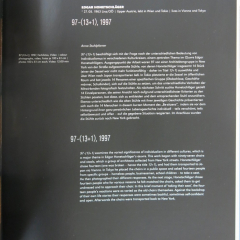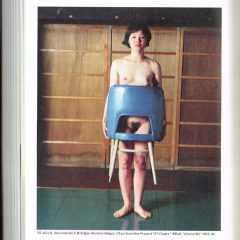Tokyo / New York / Vienna 1996
performance / Intervention / short film 12 min / photos -limited edition
first shown at DOCUMENTA X (curator Catherine David)
organizer: Yukika Kudo, photographer: Koki Suetsugu
Portraits
I have been painting chairs for more then 8 years now – all in the same technique and with the same intention. The images are red oil-paint on pure canvas and they always try to capture somebody, who for some reason has become very important in my life. I portrait people as chairs, and though painting is not my major concern, the medium in this context is chosen very carefully. Since the canvas is not being prepared, chemical processes occur on the surface of the cloth. The very thick color extracts oil which soaks the canvas. Therefore the images develop a kind of shadow- which appears as if the chairs were surrounded by an aura. I did two or three “portraits“ each year since I started in 1989.
97 – (13+1)
From November 1993 to February 1994 the POOR BOYS ENTERPRISE (a group of three young Austrian architects) collect 97 worn out chairs in the streets of New York City. They document precisely where they find those „objects“ by drawing maps and taking photographs at the locations where they find them. The chairs are assembled on the rooftop of a China town building and later on shipped over the Atlantic to Vienna. In October 1994 again all those chairs are arranged on the rooftop of a car parking facility and all sorts of people are invited to pick a chair of their choice and do with it whatever they feel like. This is when my story with those “Readymades“ begins.
I picked 14 out of those 97 chairs and took them with me to Tokyo. In Japan I lived with those chairs for a while in order to become familiar with their character.
Sentenced to the garbage dump they have been revived (or to use a more accurate word -recycled), escaping their fate, they were sent on a journey. Functional again – although mostly not in the original sense, as commodities – they serve as a potential of creativity by evoking ideas and leading to new ways of „making use“ of them. One of the chairs is in an entirely devastated condition – it can no more be used as a sitting facilities (that’s the +1). All of them have a“personal“ history and therefore their own time-momentum. I wanted them to fulfil a cycle. In Tokyo I „made use“ of the chairs, but by the time the piece was finished they were on a ship back to where they had come from. Somewhere in the streets of New York they will have to face their original fate.
PART 1 (January 1995)
In the first part I set up the chairs – lined up in a row – at different locations in TOKYO.
1) In Ueno park I asked 14 homeless to have a seat
2) In Otemachi I had 14 Salary-men sit down
3) In Fujino first 14 female, then 14 male Highschool-students took a seat
The whole process – e.g. convincing the participants and the actual „performance“ was videotaped and photographed.
PART 2 (April 1995)
As a second step I tried to find individuals, who for some reason matched an individual chair. (physiognomy, anatomy, character), It took me quite a long time to find the right people, but once I had found them I asked them to come to my studio,”meet” the chair and use it for a brief moment – a fleeting encounter. I asked each of them to take off their clothes and sit down on the chair for a little while, while I was video-taping and photographs were being taken of the scene. ( nude because dressing always means hiding the true „face“and identity). Nude the human being is most vulnerable – just as those 14 chairs who have survived a certain period of time and now show all the scars of their existence.
A moment of contact was captured. The video is the medium of the non-real, the depiction, the fiction. It just imposes that something is (was) really happening.
PART 3 (May 1997)
I sent the chairs back to New York and set them out at some place in the streets again, were they probably had to face their original fate ( going to the garbage dump).
As in my last project „Schuhwerk“ (Tokyo 1993/94) I am mainly interested in confronting individualism with conformism. (Westerners looking at Asians as a people of uniformity by defining themselves as a society of „individualists“) The obvious uniformity versus the individual. Once more I am trying to question prejudices, which exist in the west towards the eastern world. Most of these misunderstandings derive from a lack of interest to look closer into something which is not as easily approachable, as the cultural background one is grown into.
Besides this I continued working with what I call „public art“. Working with people in the street, make them part of the piece and actually have them create the art. All I do is direct, arrange and capture.
A moment of contact is being captured.The video is the medium of the non real, the depiction, the fiction. It just imposes that something is (was) really happening. A consumable story.
All those chairs – individually- do have a different time-sequence and history- from the day they were made until the day they ended up in the streets. I need not mention the obvious similarity with people. Of all commodities we use, the chair resembles us the most. To a certain extent in terms of physiognomy, but also in its „relationship“ with us and how it endures through a period of time. Historically we can look at the chair from two angles. One is the use as a commodity – as a gadget of convenience. The other one as a symbol of status. In churches and at court chairs used to come in different shapes – referring to the social status of the user. The higher ranked a person was, the more comfortable the chair had to be. But chairs were even provided for status purposes, as representational „never being used“ objects. In Romanic cathedrals there was actually only one real chair – prepared for the bishop. Even though the clergy-man was never present, nobody was allowed to use it. It was reserved for him only and represented him (substituted him) and his status.
If there is any kind of comparison to the Japanese culture it‘s the fact – that women were not allowed to sit as casually as men on the Tatami. Highest ranked personalities (Shogun) had something like a chair, which made sitting on the rice-mat more comfortable. Today „western“ chairs are part of the culture as anywhere else in the world.
There is one more thing that should not be left out. In the German language (precise as usual) the word for “to sit“ is sitzen, for “to possess“ is besitzen . Linguistically those two terms are tightly connected. “to possess“ could directly be translated to – “to sit on something”.
with Yukie Shimura, housewife / Kyoske Tsunoda, business executive / Akiko Noguchi, fashion designer / Aki Kakegawa, bartender / Yuko Yamazaki, sales girl / Junichi Yuzaka, writer / Izumi Oigo, elevator girl / Gen Kitano / Kenji Ishikawa, pianist / Ekuko Sasaki, shop owner / Tomoko Nishiuchi, student / Nobuyoshi Asano, sculptor / Masaki Tokimori, athlete / Hiroko Uemura, maiko=geisha to be








